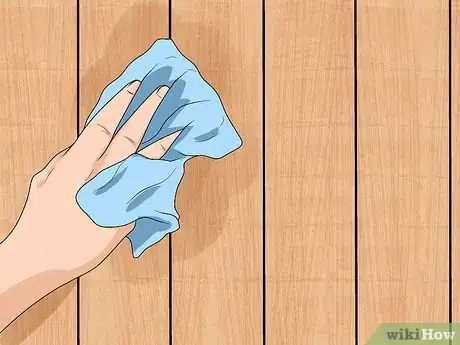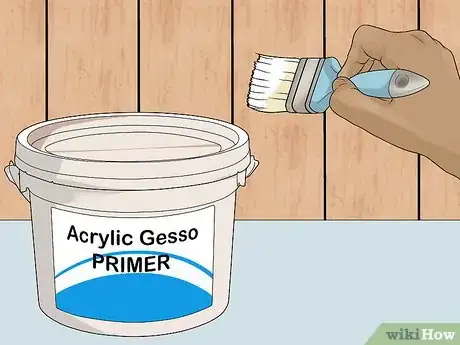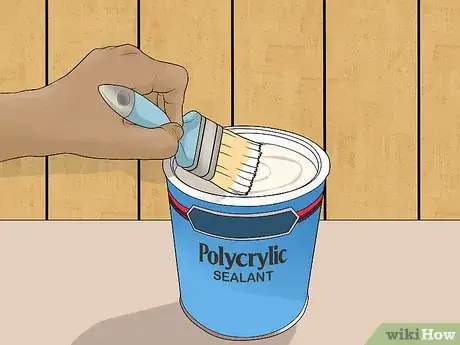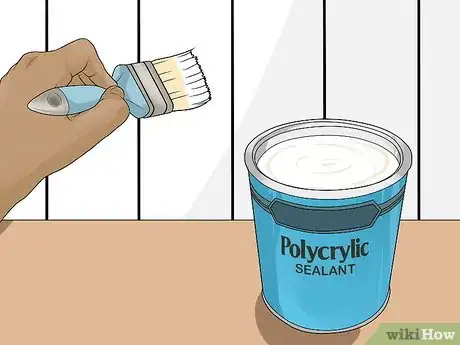This article was co-authored by Kelly Medford. Kelly Medford is an American painter based in Rome, Italy. She studied classical painting, drawing and printmaking both in the U.S. and in Italy. She works primarily en plein air on the streets of Rome, and also travels for private international collectors on commission. She founded Sketching Rome Tours in 2012 where she teaches sketchbook journaling to visitors of Rome. Kelly is a graduate of the Florence Academy of Art.
This article has been viewed 97,379 times.
If not applied properly, the paint on wood surfaces can begin to peel and chip over time. This is especially true of wood items that see frequent use, are placed in direct sunlight, or were not properly prepared and painted in the first place. By preparing your wood properly before you paint and sealing the painted wood afterwards, your painted wood items will maintain their quality for many years to come.
Steps
Preparing the Wood before You Paint
-
1Use a wet cloth to clean the wood. Leaving dirt or other particles on the wood can keep it from properly absorbing the paint, primer, and sealant. Clean the wood before applying sealant by wiping it down with a damp cloth.[1]
- You can use a tack cloth to pick up any remaining dirt. Tack cloths are gauze-like materials treated with a sticky substance and can be purchased at any home improvement store.
-
2Apply 2 coats of sealant onto the raw wood. Brush a thin coat of glossy acrylic medium sealant onto the wood using a dampened sponge or paintbrush.[2] Allow the sealant to dry, and then apply another coat to the wood. Lightly sand the wood after the second coat of sealant has dried to remove any excess sealant and then wipe it down again with a wet cloth and tack cloth.Advertisement
-
3Apply a coat of primer to help the paint adhere to the wood. Using primer provides a surface to which paint can adhere by allowing the wooden surface to regain surface tooth (ridges and valleys).[5]
-
4Allow the wood to dry and cure. In order to maximize paint adhesion, you’ll need to allow the primer time to dry. This could take several hours. Once the primer is dry to the touch, you can start applying your paint.[8]
Protecting the Paint with a Clear Sealant
-
1Choose a wax-based or polycrylic sealant. Wax-based sealants give wooden surfaces more of a flat finish, while polycrylic ones provide a glossier one. Water-based polycrylic sealants are the most versatile.[9]
- Before applying your sealant, clean, sand, and wipe down the wood.
-
2Use a sponge, cloth, or paintbrush to apply the sealant. Dip a dampened sponge, cloth, or paintbrush in the sealant, and apply a thin layer of the sealant to the wood. Allow the sealant to dry to the touch.[10]
- Cloths are used more for wax-based sealants, sponges for polycrylic sealants applied to surfaces with grooves or curves, and paintbrushes for flat surfaces.
-
3Apply a second coat of sealant. After the first coat of sealant has dried to the touch, repeat the process of applying sealant with a sponge, cloth or paintbrush. Doing so will ensure that the painted wood is fully protected.[11]
-
4Allow the sealant to cure for 2-3 weeks. Just because the surface of the wood is dry to the touch doesn’t mean that it is fully dry. Allow the sealant to dry and cure for 2-3 weeks after application. Do not put anything on the surface, because it can cause damage or imperfections.[12]
- In hot or humid weather, sealant can take longer to dry and should be allowed to sit for a longer period of time.[13]
Expert Q&A
-
QuestionCan you paint acrylic directly on wood?
 Kelly MedfordKelly Medford is an American painter based in Rome, Italy. She studied classical painting, drawing and printmaking both in the U.S. and in Italy. She works primarily en plein air on the streets of Rome, and also travels for private international collectors on commission. She founded Sketching Rome Tours in 2012 where she teaches sketchbook journaling to visitors of Rome. Kelly is a graduate of the Florence Academy of Art.
Kelly MedfordKelly Medford is an American painter based in Rome, Italy. She studied classical painting, drawing and printmaking both in the U.S. and in Italy. She works primarily en plein air on the streets of Rome, and also travels for private international collectors on commission. She founded Sketching Rome Tours in 2012 where she teaches sketchbook journaling to visitors of Rome. Kelly is a graduate of the Florence Academy of Art.
Professional Painter You need to prepare the wood before you begin painting. Start by sanding the wood and then putting two layers of shellac on the piece to be safe. You can buy prepared shellac from the hardware store or prepare it yourself. You can also use acrylic gesso. And once the acrylic paint is dry, you should finish with varnish.
You need to prepare the wood before you begin painting. Start by sanding the wood and then putting two layers of shellac on the piece to be safe. You can buy prepared shellac from the hardware store or prepare it yourself. You can also use acrylic gesso. And once the acrylic paint is dry, you should finish with varnish. -
QuestionHow long does it take for acrylic paint to dry on wood?
 wikiHow Staff EditorThis answer was written by one of our trained team of researchers who validated it for accuracy and comprehensiveness.
wikiHow Staff EditorThis answer was written by one of our trained team of researchers who validated it for accuracy and comprehensiveness.
Staff Answer wikiHow Staff EditorStaff AnswerIt varies depending on how thick the paint is and how humid the environment is, but it typically takes acrylic paint only 1-2 hours to dry. However, it may take about a week to cure completely.
wikiHow Staff EditorStaff AnswerIt varies depending on how thick the paint is and how humid the environment is, but it typically takes acrylic paint only 1-2 hours to dry. However, it may take about a week to cure completely. -
QuestionShould I varnish my acrylic painting?
 wikiHow Staff EditorThis answer was written by one of our trained team of researchers who validated it for accuracy and comprehensiveness.
wikiHow Staff EditorThis answer was written by one of our trained team of researchers who validated it for accuracy and comprehensiveness.
Staff Answer wikiHow Staff EditorStaff AnswerVarnishing your painting is a good idea. The varnish will help protect your painting from dust, yellowing, and sun damage. It also adds a nice sheen that can help the colors look more radiant. Make sure the paint is completely dry before you add the varnish.
wikiHow Staff EditorStaff AnswerVarnishing your painting is a good idea. The varnish will help protect your painting from dust, yellowing, and sun damage. It also adds a nice sheen that can help the colors look more radiant. Make sure the paint is completely dry before you add the varnish.
Things You’ll Need
- Washcloth
- Tack cloth
- Sandpaper
- Sponge
- Paintbrush
- Sealant
- Primer
References
- ↑ http://nooga.com/168937/the-diy-designer-how-to-keep-paint-from-peeling-or-scratching-off-your-newly-painted-furniture/
- ↑ http://nancyreyner.com/prepare-wood-panels-painting/
- ↑ https://www.justthewoods.com/sealing-painted-furniture/
- ↑ http://nancyreyner.com/prepare-wood-panels-painting/
- ↑ http://nancyreyner.com/prepare-wood-panels-painting/
- ↑ http://nancyreyner.com/prepare-wood-panels-painting/
- ↑ http://nancyreyner.com/prepare-wood-panels-painting/
- ↑ http://nancyreyner.com/prepare-wood-panels-painting/
- ↑ http://nooga.com/169338/the-diy-designer-what-kind-of-topcoat-should-i-use-and-when/
- ↑ http://nooga.com/168937/the-diy-designer-how-to-keep-paint-from-peeling-or-scratching-off-your-newly-painted-furniture/
- ↑ http://nooga.com/168937/the-diy-designer-how-to-keep-paint-from-peeling-or-scratching-off-your-newly-painted-furniture/
- ↑ http://nooga.com/168937/the-diy-designer-how-to-keep-paint-from-peeling-or-scratching-off-your-newly-painted-furniture/
- ↑ http://nooga.com/168937/the-diy-designer-how-to-keep-paint-from-peeling-or-scratching-off-your-newly-painted-furniture/
About This Article
To protect acrylic paint on wood, you’ll need to apply a clear sealant. Choose a wax-based sealant for a flat finish or a polycrylic sealant for a glossier finish. Once the paint has dried on your wood surface, apply a thin layer of your sealant with a dampened sponge, cloth, or paintbrush. When it’s dried to the touch, apply a second coat of sealant to improve its protection. Although the sealant might dry within hours, you’ll need to wait 2-3 weeks before it’s fully cured. Avoid putting anything on the surface during this time, since it can cause damage or imperfections. For more tips from our Decorating co-author, including how to prepare your wood before you paint it, read on!





























































